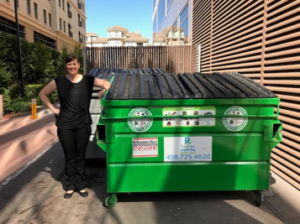More packages mean more garbage, especially in fast-growing cities where the bulk of waste is generated, putting pressure on multifamily owners and managers to deal with rising costs and environmental impacts. While programs like ENERGY STAR® include waste-tracking tools, there is no benchmark in place by which owners can compare waste management measures.
During the “Talkin’ Trash” session at NMHC OPTECH, Craig Haglund, Program Manager – CRE & Multifamily, U.S. EPA, ENERGY STAR® Commercial & Industrial Branch moderated and speakers: Jana Alfiero, Waste Solutions Specialist at Cortland and Mary Nitschke, Director of Ancillary Services from Prometheus Real Estate Group Inc and President of the Utility Management Advisory shared their insider insights into the major logistical and operational tasks involved in keeping multifamily communities out from under the trash heap.
Craig shared how changing consumer behaviors are impacting trash logistics, specifically, online shopping is exploding which requires protective packaging for shipping. What’s great for convince is adding volume to our trash and recycling receptacles. Exacerbating the problem is China’s recent reluctance to accept our recycling materials. His first tip is to measure what you manage. EPA Energy Star provides trash tracking software that can show your trash and recycling trends. Once you have that data, you can target improvements.
“Trash is an ignored area. It’s not flashy like smart apartments or gym equipment but trash enclosures are visited between one and five times a week. They’re one of the most visited amenity spaces!” pointed out Mary.
Cardboard is coming into properties from all directions: move-ins, ecommerce, maintenance deliveries. It adds up quickly. So, what can a property manager do? “Resident education is your first line of defense” offered Mary. “When your residents are getting their welcome tour why not show them the trash area and discuss the property’s recycling efforts. This is probably the first amenity they’re going to visit anyway. Today’s residents have a strong social conscious. They want to be environmentally helpful. They just need a little guidance. Oh, and proper signage goes a long way.”
“It’s also important to provide your residents with guidelines on what can be recycled and composted. It can change from City to City, hauler to hauler. Additionally you may be required by regulation to have recycling and even composting at your communities. In California for example, regulation requires that we have a compost diversion stream at our communities by July of 2019. The City can levy penalties against us if we don’t. In some markets we are seeing penalties assessed for contamination in recycling or compost, or the hauler just simply won’t pick it up. Both are problems.”
Okay, you are tracking your waste and your residents are all onboard. What are some other insider tips? “You’ve got to know your numbers,” commented Jana. “Examine your waste contracts. When do they expire? What are the renewal terms? Sometimes haulers charge a minimum or add an automatic 1 or two 7-8% increases a year. This can add up quickly.” She suggests sticking to 1-year contracts without any rate increases. “Other items to look out for are trip charges when they can’t access a bin and contamination charges. Make sure those are specified in the contract. You want to minimize the unknown.” Another tip is to rent, not buy your equipment because maintenance is included, and you can negotiate newer equipment as the term expires.
If we ignore the trash issue our residents will still generate and dispose of trash but we’ll probably not like their solution. Let’s help them and our facilities team make the most environmentally sound and aesthetically pleasing choice. Being proactive goes a long way to stop trash issues from piling up and keeping costs under control.

